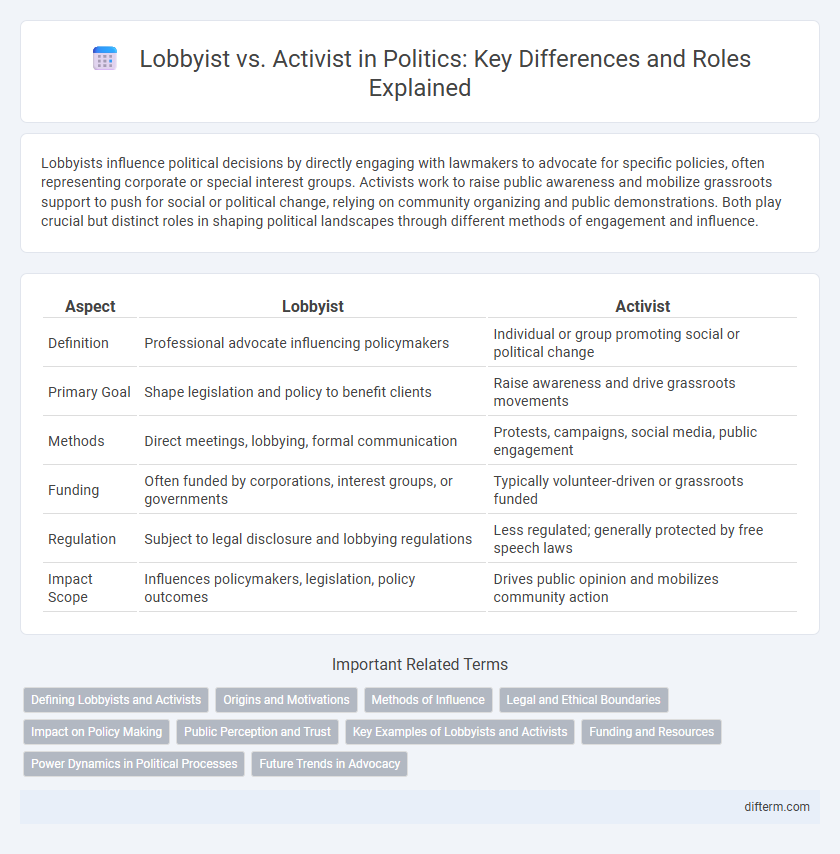Lobbyists influence political decisions by directly engaging with lawmakers to advocate for specific policies, often representing corporate or special interest groups. Activists work to raise public awareness and mobilize grassroots support to push for social or political change, relying on community organizing and public demonstrations. Both play crucial but distinct roles in shaping political landscapes through different methods of engagement and influence.
Table of Comparison
| Aspect | Lobbyist | Activist |
|---|---|---|
| Definition | Professional advocate influencing policymakers | Individual or group promoting social or political change |
| Primary Goal | Shape legislation and policy to benefit clients | Raise awareness and drive grassroots movements |
| Methods | Direct meetings, lobbying, formal communication | Protests, campaigns, social media, public engagement |
| Funding | Often funded by corporations, interest groups, or governments | Typically volunteer-driven or grassroots funded |
| Regulation | Subject to legal disclosure and lobbying regulations | Less regulated; generally protected by free speech laws |
| Impact Scope | Influences policymakers, legislation, policy outcomes | Drives public opinion and mobilizes community action |
Defining Lobbyists and Activists
Lobbyists are professionals who influence government decisions by advocating for specific policies on behalf of corporations, interest groups, or organizations through direct interaction with policymakers. Activists, in contrast, mobilize public opinion and grassroots support to drive social or political change, often engaging in protests, campaigns, and awareness efforts. While lobbyists operate within formal political channels, activists rely on public engagement to pressure decision-makers.
Origins and Motivations
Lobbyists typically originate from professional backgrounds in law, business, or government, driven by the motivation to influence policy in favor of specific corporate or organizational interests through strategic networking and financial contributions. Activists usually emerge from grassroots movements or social justice causes, motivated by a desire to effect change on societal issues such as human rights, environmental protection, or political reform. While lobbyists focus on maintaining or enhancing established power structures, activists challenge these structures to promote equity and public accountability.
Methods of Influence
Lobbyists primarily use direct strategies such as meeting with policymakers, providing expert information, and funding political campaigns to shape legislation. Activists rely on grassroots mobilization, public demonstrations, social media campaigns, and petition drives to raise awareness and pressure decision-makers. Both employ strategic communication, but lobbyists leverage institutional access while activists harness public opinion for influence.
Legal and Ethical Boundaries
Lobbyists operate within legal frameworks by registering with government bodies and adhering to transparency regulations that require disclosure of their activities and funding sources. Activists, while often engaging in public demonstrations and advocacy efforts, must also comply with laws pertaining to protests, free speech, and permits to avoid legal penalties. Ethical boundaries for both groups hinge on maintaining honesty, avoiding undue influence or coercion, and respecting the democratic process to ensure their efforts do not compromise public trust or policy integrity.
Impact on Policy Making
Lobbyists leverage formal channels and financial resources to influence legislators and shape policy agendas, often representing corporate or special interest groups. Activists mobilize public opinion and grassroots campaigns to apply pressure on policymakers, driving changes through widespread civic engagement and media attention. Both play critical roles in policymaking, with lobbyists providing direct access to decision-makers and activists fostering democratic participation and accountability.
Public Perception and Trust
Lobbyists are often perceived as representing corporate or special interest agendas, which can lead to public skepticism and concerns about undue influence on policymakers. Activists, by contrast, are typically seen as champions of grassroots movements and social change, fostering higher levels of trust and legitimacy among the public. Trust disparities between lobbyists and activists significantly shape public attitudes toward political advocacy and influence democratic engagement.
Key Examples of Lobbyists and Activists
Key examples of lobbyists include firms like Brownstein Hyatt Farber Schreck and individuals such as Tony Podesta, who influence legislation through targeted advocacy and financial contributions. Prominent activists such as Greta Thunberg and Martin Luther King Jr. have driven social and political change by mobilizing public opinion and organizing grassroots movements. Both lobbyists and activists play crucial roles in shaping policy, with lobbyists focusing on direct engagement with lawmakers and activists emphasizing public awareness and mass action.
Funding and Resources
Lobbyists often have significant funding from corporations, trade associations, or interest groups, enabling them to access extensive resources including expert research, targeted advertising, and direct access to policymakers. Activists typically rely on grassroots funding, donations, and volunteer efforts, which may limit their financial resources but foster broad public support and community engagement. The disparity in funding influences the scale and reach of their political influence, with lobbyists leveraging financial power to shape legislation and activists mobilizing public opinion to drive change.
Power Dynamics in Political Processes
Lobbyists exert influence through strategic relationships with policymakers, leveraging financial resources and insider access to shape legislation and regulatory outcomes. Activists rely on grassroots mobilization, public pressure, and media campaigns to challenge established power structures and drive political change from the outside. The interplay between lobbyists' institutional power and activists' collective action highlights contrasting mechanisms that shape agenda-setting and policy formulation in democratic systems.
Future Trends in Advocacy
Lobbyists are expected to leverage advanced data analytics and artificial intelligence to influence policy decisions more precisely, while activists will increasingly utilize social media platforms and decentralized digital tools to mobilize grassroots campaigns globally. The rise of transparent lobbying regulations aims to reshape the interaction between corporate interests and policymakers, pushing lobbyists toward greater accountability. Activists are likely to adopt hybrid approaches combining online advocacy with traditional protest methods to sustain momentum and impact future political landscapes.
lobbyist vs activist Infographic

 difterm.com
difterm.com